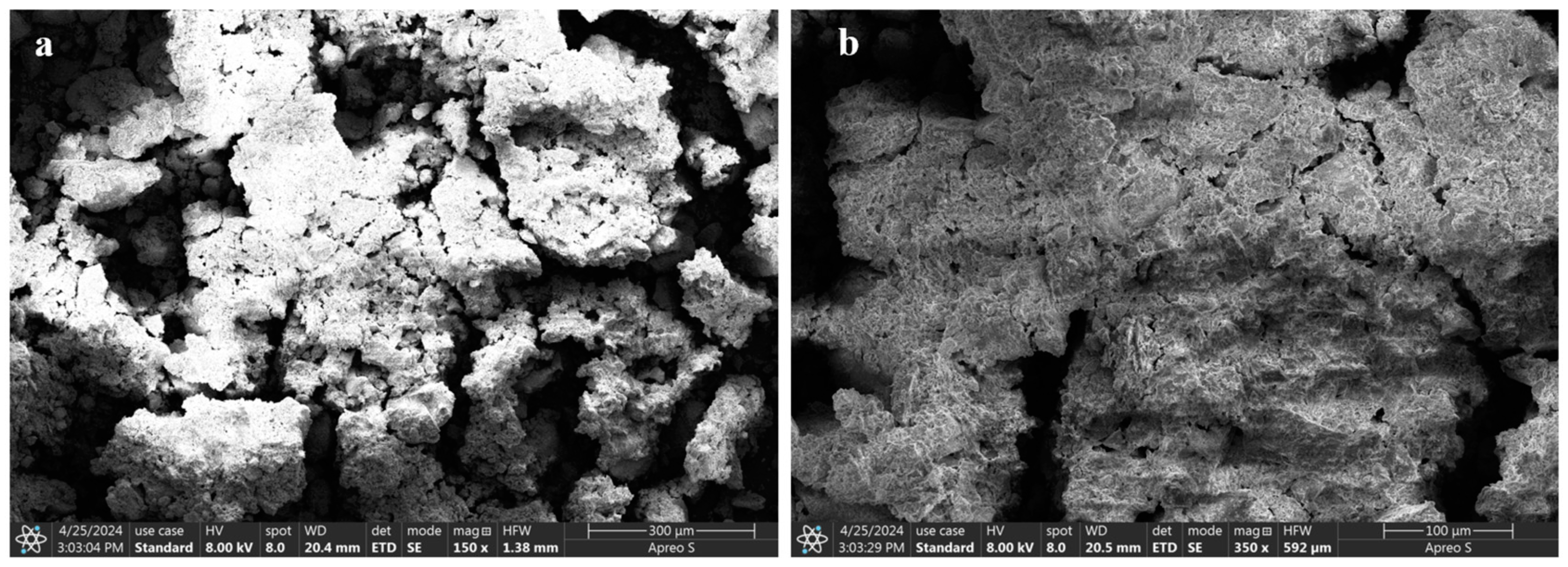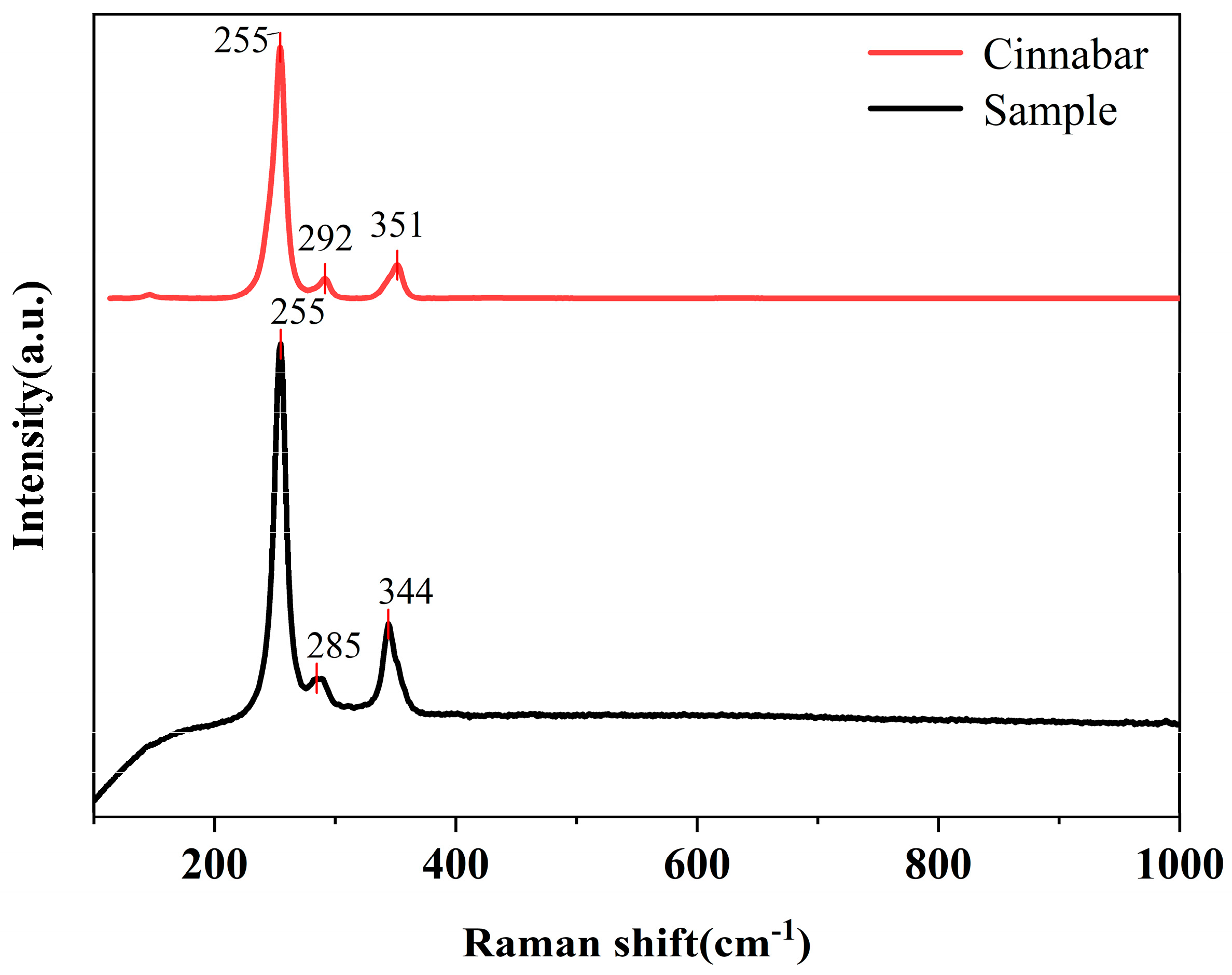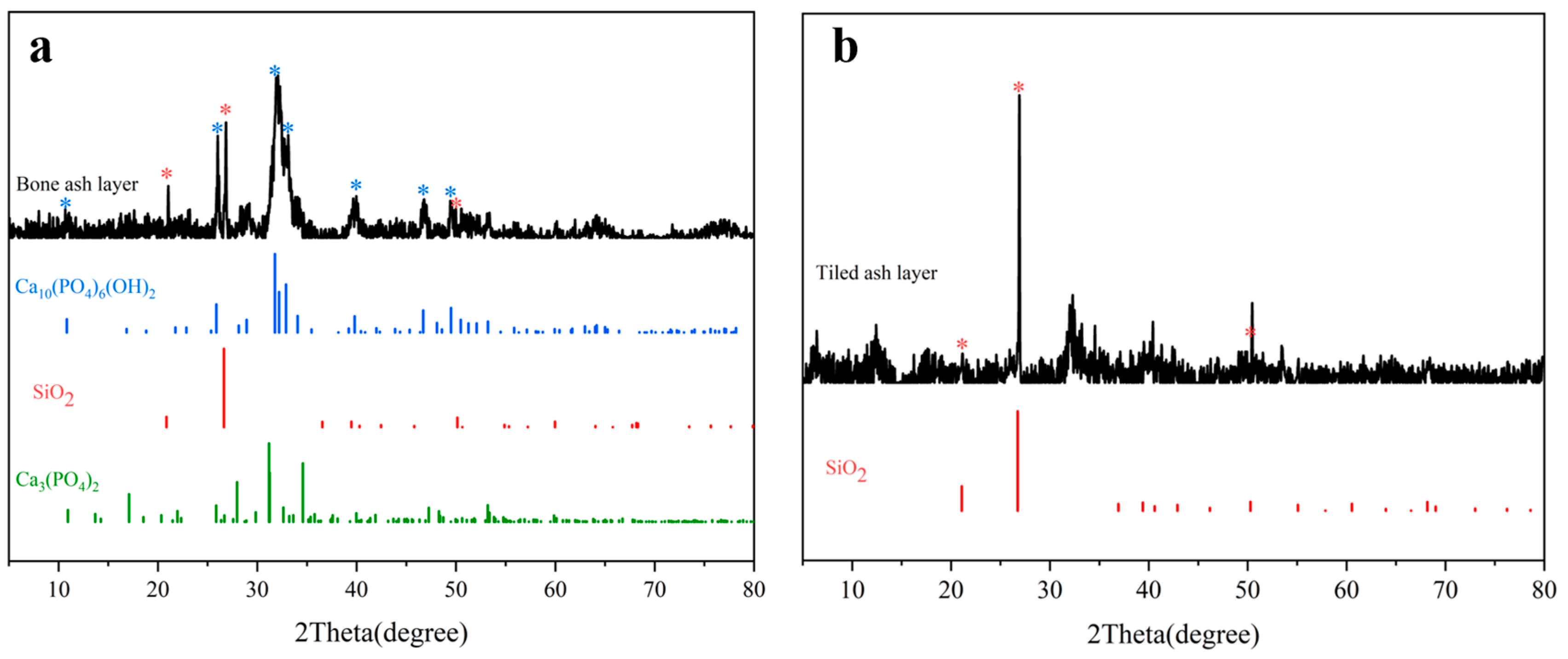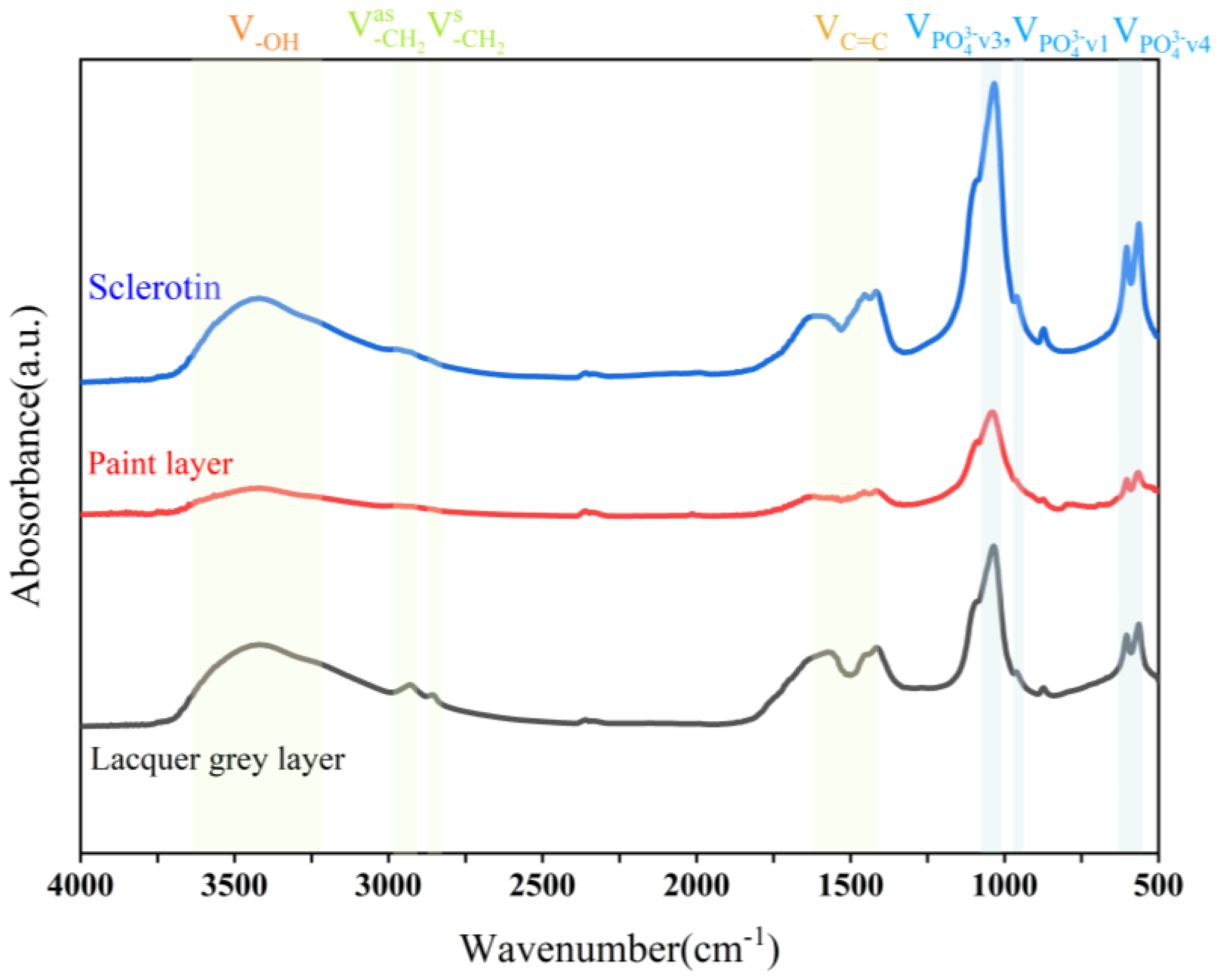The Lacquer Craft of the Corridor Coffin (徼道棺) from Tomb No. 2 of Tushan in Eastern Han Dynasty, Xuzhou
Abstract
1. Introduction
2. Materials and Methods
2.1. Samples
2.2. Experimental Instruments and Methods
2.2.1. Ultra-Depth Microscope
2.2.2. Scanning Electron Microscope (SEM)
2.2.3. X-ray Energy Dispersive Spectroscopy (EDS)
2.2.4. X-ray Diffraction (XRD)
2.2.5. Fourier Transform Infrared Spectroscopy (FT-IR)
2.2.6. Micro-Raman Spectroscopy
3. Results and Discussion
3.1. Structural Composition Analysis
3.2. Pigment Layer Analysis
3.3. Analysis of the Lacquer Ash Layer
4. Conclusions
Author Contributions
Funding
Institutional Review Board Statement
Informed Consent Statement
Data Availability Statement
Acknowledgments
Conflicts of Interest
References
- Chang, J.; Schilling, M.R. Reconstructing lacquer technology through Chinese classical texts. Stud. Conserv. 2016, 61, 38–44. [Google Scholar] [CrossRef]
- Fang, L. Ceramics of the Qin and Han Dynasties the History of Chinese Ceramics; Springer Nature Singapore: Singapore, 2023; pp. 127–177. [Google Scholar]
- Szczepanowska, H.; Ploeger, R. The Chemical analysis of southeast asian lacquers collected from forests and workshops in Vietnam, Cambodia, and Myanmar. J. Cult. Herit. 2019, 40, 215–225. [Google Scholar] [CrossRef]
- Colomban, P.; Mancini, D. Lacquerware pigment identification with fixed and mobile raman microspectrometers: A potential technique to differentiate original fake artworks. Arts 2013, 2, 111–123. [Google Scholar] [CrossRef]
- Pintus, V.; Baragona, J.; Wieland, K.; Miklin-Kniefacz, S.; Haisch, C.; Schreiner, M. Comprehensive multi-analytical investigations on the Vietnamese lacquered wall-panel “The Return of the Hunters” by Jean Dunand. Sci. Rep. 2019, 9, 18837. [Google Scholar] [CrossRef]
- Huang, Y.; Fu, Y.C.; Shen, D.; Lindahl, K.; Wei, S. Characterization and identification of an archaeological “lacquer” pipe. Herit. Sci. 2024, 12, 142. [Google Scholar] [CrossRef]
- Liu, Y. Archaeological Manifestations of Rank and Status, the Wooden Chamber Tombs in the Mid-Yangzi Region (206 BC-AD 25). Ph.D. Thesis, University of Oxford, Oxfordshire, UK, 2015. [Google Scholar]
- Zheng, L.; Wang, L.; Zhao, X.; Xi, K.Z.; Wu, X.Z.; Fan, X.P. Characterization of the Materials and Techniques of Red Lacquer Painting of a Horizontal Plaque Inscribed by General Feng Yü-hsiang. Coatings 2023, 13, 583. [Google Scholar] [CrossRef]
- Scovil, J. A mineral excursion to China: 2004. Rocks Miner. 2005, 80, 12–22. [Google Scholar] [CrossRef]
- Hao, X.Y.; Wang, X.; Zhao, Y.; Tong, T.; Gong, Y.X. Identification of minerals and mineral pigments in lacquer by the comprehensive comparative analysis of spectroscopy information. Spectrosc. Lett. 2021, 54, 446–457. [Google Scholar] [CrossRef]
- Li, T.; Xie, Y.F.; Yang, Y.M.; Yang, Y.M.; Wang, C.S.; Fang, X.Y.; Shi, J.L.; He, Q.J. Pigment identification and decoration analysis of a 5th century Chinese lacquer painting screen: A micro-Raman and FTIR study. J. Raman. Spectrosc. 2009, 40, 1911–1918. [Google Scholar] [CrossRef]
- Wang, R.; Nie, F.; Chen, J.M.; Li, Y.F. Studies on the Ground Layer of Lacquerwares from Between the Mid-Warring States Period and the Mid-Western Han Dynasty Unearthed in the Changsha Region. Archaeometry 2017, 59, 105–120. [Google Scholar] [CrossRef]
- Jin, P.J.; Liu, C.H.; Zhu, J.X. Preliminary study on the lacquers Unearthed from T23 of No. 1 in terracotta warrior and horse figure pit. New Comments Conserv. Cult. Relics 2012, 3, 144–150. [Google Scholar]
- Zhao, H.X.; Li, Q.H.; Liu, S.; Hu, Y.Q.; Gan, F.X. Nondestructive analysis of jade artifacts from the Cemetery of the Ying State in Henan Province, China using confocal Raman microspectroscopy and portable X-ray fluorescence spectroscopy. J. Raman. Spectrosc. 2014, 45, 173–178. [Google Scholar] [CrossRef]
- Paterlini, V.; Bettinelli, M.; Rizzi, R.; El Khouri, K.A.; Rossi, M.; Della Ventura, G.; Capitelli, F. Characterization and luminescence of Eu3+-and Gd3+-doped hydroxyapatite Ca10(PO4)6(OH)2. Crystals 2020, 10, 806. [Google Scholar] [CrossRef]
- Sung, M.; Jung, J.; Lu, R.; Miyakoshi, T. Study of historical Chinese lacquer culture and technology–Analysis of Chinese Qin-Han dynasty lacquerware. J. Cult. Herit. 2016, 21, 889–893. [Google Scholar] [CrossRef]
- Jin, P.J.; Hu, Y.L.; Ke, Z.B. Characterization of lacquer films from the middle and late Chinese warring states period 476–221BC. Microsc. Res. Tech. 2017, 80, 1344–1350. [Google Scholar] [CrossRef] [PubMed]
- Xia, J.R.; Xu, Y.L.; Lin, J.H. UV-induced polymerization of urushiol. II: Effects of hydrogenation degree of urushiol on surface morphology. Prog. Org. Coat 2010, 67, 365–369. [Google Scholar] [CrossRef]
- Liu, X.Y.; Lv, M.Q.; Liu, M.; Wu, Z.H.; Lv, J.H. Characterization and identification of lacquer films from the Qin and Han Dynasties. BioResources 2019, 14, 9509–9517. [Google Scholar] [CrossRef]
- Yang, J.H.; Zhu, J.F.; Liu, W.H.; Deng, J.P.; Ding, Y.Y. Prepolymerization of lacquer sap under pure oxygen atmosphere and its effects on the properties of lacquer film. Int. J. Polym. Sci. 2015, 2015, 517202. [Google Scholar] [CrossRef]
- Fu, Y.C.; Chen, Z.F.; Zhou, S.L.; Wei, S.Y. Comparative study of the materials and lacquering techniques of the lacquer objects from Warring States Period China. J. Archaeol. Sci. 2020, 114, 105060. [Google Scholar] [CrossRef]
- Li, X.Y.; Wu, X.J.; Zhao, Y.; Wen, Q.Y.; Xie, Z.B.; Yuan, Y.H.; Tong, T.; Shen, X.Y.; Tong, H. Composition/structure and lacquering craft analysis of Wenzhou Song dynasty lacquerware. Anal. Methods 2016, 8, 6529–6536. [Google Scholar] [CrossRef]
- Ion, R.-M.; Iancu, L.; Grigorescu, R.M.; Slamnoiu-Teodorescu, S.; Dulama, I.; Bucurica, L.A. Degradation Products Assessment of the Wooden Painted Surfaces from a XVIIth Heritage Monastery. Appl. Sci. 2023, 13, 2124. [Google Scholar] [CrossRef]
- Pagnin, L.; Calvin, R.; Wiesinger, R.; Weber, J.; Schreiner, M. Photodegradation kinetics of alkyd paints: The influence of varying amounts of inorganic pigments on the stability of the synthetic binder. Front. Mater. 2020, 7, 600887. [Google Scholar] [CrossRef]
- Ildefonse, P.; Morin, G. Chemical and structural changes in Cervus elaphus tooth enamels during fossilization (Lazaret cave): A combined IR and XRD Rietveld analysis. Appl. Geochem. 1995, 10, 145–159. [Google Scholar]
- Miller, L.M.; Vairavamurthy, V.; Chance, M.R.; Mendelsohn, R.; Paschalis, E.P.; Betts, F.; Boskey, A.L. In situ analysis of mineral content and crystallinity in bone using infrared micro-spectroscopy of the ν4 PO43− vibration. BBA-Gen Subj. 2001, 1527, 11–19. [Google Scholar] [CrossRef] [PubMed]
- Turner-Walker, G.; Xu, B.Y. Identification of animal hard tissues using Fourier transform infrared spectroscopy, Natural History collections. In Proceedings of the Preprints ICOM-CC 17th Triennial Conference, Melbourne, Australia, 15 September 2014. [Google Scholar]
- Wu, M.; Zhang, Y.F.; Zhang, B.J.; Li, L. Study of colored lacquerwares from Zenghou Yi Tomb in early Warring States. New J. Chem. 2021, 45, 9434–9442. [Google Scholar] [CrossRef]
- Chen, D. The Design Aesthetics of Lacquerware in the Han Dynasty. International Conference on Education, Language, Art and Intercultural Communication (ICELAIC-14); Atlantis Press: Amsterdam, The Netherlands, 2014; pp. 526–530. [Google Scholar]
- Wei, S.Y.; Pintus, V.; Pitthard, V.; Schreiner, M.; Song, G.D. Analytical characterization of lacquer objects excavated from a Chu tomb in China. J. Archaeol. Sci. 2011, 38, 2667–2674. [Google Scholar] [CrossRef]
- Yang, J. The underground luxury of a Western Han Marquis: Major discoveries from the tomb of the Marquis of Haihun in Nanchang. Asian Archaeol. 2019, 2, 65–102. [Google Scholar] [CrossRef]
- Ma, X.; Shi, Y.; Khanjian, H.; Schilling, M.; Li, M.; Fang, H.; Cui, D.; Kakoulli, l. Characterization of early imperial lacquerware from the luozhuang Han tomb, China. Archaeometry 2017, 59, 121–132. [Google Scholar] [CrossRef]








| C | O | Hg | S | Ba | Si | Ca | Al |
|---|---|---|---|---|---|---|---|
| 30.5% | 17.4% | 34.6% | 7.1% | 8.5% | 0.9% | 0.6% | 0.4% |
| C | O | Ca | P | Si | Al | Fe | Na |
|---|---|---|---|---|---|---|---|
| 28.7% | 47.3% | 14.4% | 4.6% | 2.7% | 1.0% | 0.8% | 0.4% |
Disclaimer/Publisher’s Note: The statements, opinions and data contained in all publications are solely those of the individual author(s) and contributor(s) and not of MDPI and/or the editor(s). MDPI and/or the editor(s) disclaim responsibility for any injury to people or property resulting from any ideas, methods, instructions or products referred to in the content. |
© 2024 by the authors. Licensee MDPI, Basel, Switzerland. This article is an open access article distributed under the terms and conditions of the Creative Commons Attribution (CC BY) license (https://creativecommons.org/licenses/by/4.0/).
Share and Cite
Li, Z.; Li, X.; Yu, J.; Sun, Y.; Geng, J.; Zhao, X. The Lacquer Craft of the Corridor Coffin (徼道棺) from Tomb No. 2 of Tushan in Eastern Han Dynasty, Xuzhou. Coatings 2024, 14, 1222. https://doi.org/10.3390/coatings14091222
Li Z, Li X, Yu J, Sun Y, Geng J, Zhao X. The Lacquer Craft of the Corridor Coffin (徼道棺) from Tomb No. 2 of Tushan in Eastern Han Dynasty, Xuzhou. Coatings. 2024; 14(9):1222. https://doi.org/10.3390/coatings14091222
Chicago/Turabian StyleLi, Zongmin, Xiaojun Li, Jinyong Yu, Yihua Sun, Jianjun Geng, and Xing Zhao. 2024. "The Lacquer Craft of the Corridor Coffin (徼道棺) from Tomb No. 2 of Tushan in Eastern Han Dynasty, Xuzhou" Coatings 14, no. 9: 1222. https://doi.org/10.3390/coatings14091222
APA StyleLi, Z., Li, X., Yu, J., Sun, Y., Geng, J., & Zhao, X. (2024). The Lacquer Craft of the Corridor Coffin (徼道棺) from Tomb No. 2 of Tushan in Eastern Han Dynasty, Xuzhou. Coatings, 14(9), 1222. https://doi.org/10.3390/coatings14091222






